
Birmingham Town Hall is a concert hall and venue for popular assemblies opened in 1834 and situated in Victoria Square, Birmingham, England. It is a Grade I listed building.

Birmingham Museum and Art Gallery (BM&AG) is a museum and art gallery in Birmingham, England. It has a collection of international importance covering fine art, ceramics, metalwork, jewellery, natural history, archaeology, ethnography, local history and industrial history.
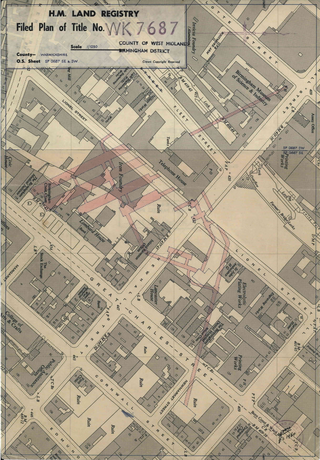
Anchor Exchange was an underground, hardened telephone exchange built in Birmingham, England.
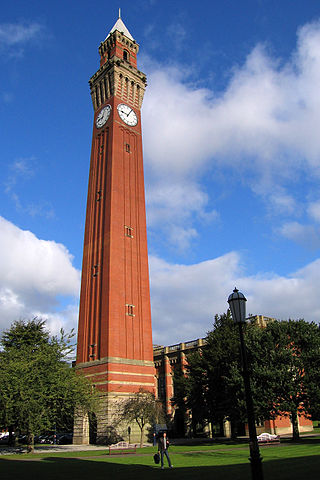
The Joseph Chamberlain Memorial Clock Tower, or colloquially Old Joe, is a clock tower and campanile located in Chancellor's court at the University of Birmingham, in the suburb of Edgbaston. It is the tallest free-standing clock tower in the world, although its actual height is the subject of some confusion. The university lists it variously as 110 metres (361 ft), 99 metres (325 ft), and 100 metres tall, the last of which is supported by other sources. In a lecture in 1945, Mr C. G. Burton, secretary of the University, stated that "the tower stands 329 ft [100 m] high, the clock dials measure 17 ft [5.2 m] in diameter, the length of the clock hands are 10 and 6 ft [3.0 and 1.8 m], and the bell weighs 5 long tons [5.1 tonnes]".
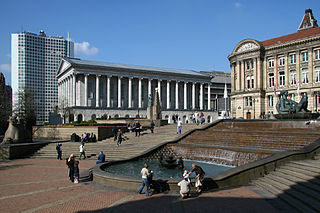
Victoria Square is a pedestrianised public square in Birmingham, England. It is home to both the Town Hall and the Council House, and directly adjacent to Chamberlain Square. It is named in honour of Queen Victoria.

Key Hill Cemetery, originally called Birmingham General Cemetery, is a cemetery in Hockley, Birmingham, England. It opened in 1836 as a nondenominational cemetery, and is the oldest cemetery, not being in a churchyard, in Birmingham. The principal entrance is on Icknield Street to the west, with a secondary entrance on Key Hill to the north. The cemetery contains the graves of many prominent members of Birmingham society in the late 19th century, to the extent that in 1915 E. H. Manning felt able to dub it "the Westminster Abbey of the Midlands".

Birmingham Ladywood is a constituency in the city of Birmingham that was created in 1918. The seat has been represented in the House of Commons of the Parliament of the United Kingdom by Shabana Mahmood of the Labour Party since 2010. Mahmood currently serves as Lord Chancellor and Secretary of State for Justice under the government of Keir Starmer.

The Jewellery Quarter is an area of central Birmingham, England, in the north-western area of Birmingham City Centre, with a population of 19,000 in a 1.07-square-kilometre (264-acre) area.
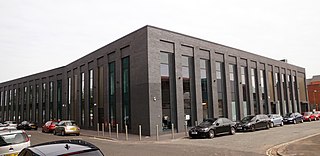
The Birmingham Assay Office, one of the four assay offices in the United Kingdom, is located in the Jewellery Quarter, Birmingham. The development of a silver industry in 18th century Birmingham was hampered by the legal requirement that items of solid silver be assayed, and the nearest Assay Offices were in Chester and London. Matthew Boulton and Birmingham's other great industrialists joined forces with silversmiths of Sheffield to petition Parliament for the establishment of Assay Offices in their respective cities. In spite of determined opposition by London silversmiths, an Act of Parliament was passed in March 1773, just one month after the original petition was presented to Parliament, to allow Birmingham and Sheffield the right to assay silver. The Birmingham Assay Office opened on 31 August 1773 and initially operated from three rooms in the King's Head Inn on New Street employing only four staff and was only operating on a Tuesday. The first customer on that day was Matthew Boulton.

The Argent Centre is a Grade II* listed building on the corner of Frederick Street and Legge Road in the Jewellery Quarter of Birmingham, England.
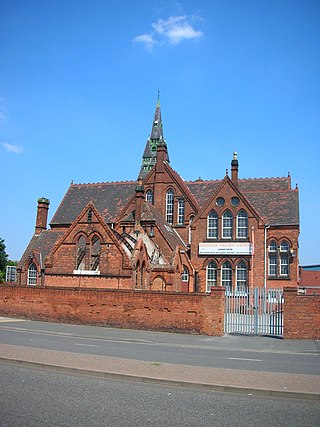
Icknield Street School, near the Hockley Flyover, north of the Jewellery Quarter, Birmingham, England, is a good example of a Birmingham board school. It is owned by Birmingham City Council.

The Chamberlain Memorial, also known as the Chamberlain Memorial Fountain, is a monument in Chamberlain Square, Birmingham, England, erected in 1880 to commemorate the public service of Joseph Chamberlain (1836–1914), Birmingham businessman, councillor, mayor, Member of Parliament, and statesman. An inauguration ceremony was held on 20 October 1880, when Chamberlain himself was present.

Spring Hill Library is a red brick and terracotta Victorian building in Ladywood, Birmingham, England.

The Twang are an English indie rock band, formed in 2004 in Birmingham. The band have released five studio albums - Love It When I Feel Like This (2007), Jewellery Quarter (2009), 10:20 (2012), Neon Twang (2014), If Confronted Just Go Mad (2019) and a B-sides compilation, Subscription (2017). Consisting of vocalist and guitarist Phil Etheridge, bassist Jon Watkin, guitarist Stu Hartland, drummer Ash Sheehan, and new backing singers Cat Mctigue and Rio Hellyer, the band garnered national acclaim when NME magazine produced an article on music acts in the West Midlands. The band's original line-up consisted of Etheridge and Saunders, Watkin, Hartland & Matty Clinton on drums.

Birmingham city centre, also known as Central Birmingham, is the central business district of Birmingham, England. The area was historically in Warwickshire. Following the removal of the Inner Ring Road, the city centre is now defined as being the area within the Middle Ring Road. The city centre is undergoing massive redevelopment with the Big City Plan, which means there are now nine emerging districts and the city centre is approximately five times bigger.
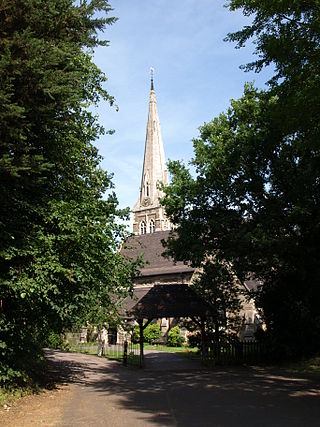
St. Mary's Church, Selly Oak is a Church of England parish church in Selly Oak, Birmingham, England.

Newman Brothers at The Coffin Works is a museum in the Newman Brothers Coffin Furniture Factory building in the Jewellery Quarter conservation area in Birmingham, England. The museum educates visitors about the social and industrial history of the site, which operated from 1894–1998 as a coffin furniture factory. The museum opened in October 2014 after a fifteen-year campaign by the Birmingham Conservation Trust to save the factory building, which ceased trading in 1998, and raise the funds to transform it into a heritage attraction. Located at 13–15 Fleet Street, the building is Grade II* listed.
Smith and Pepper was a jewellery manufacturing firm in Birmingham, England, which traded between 1899 and 1981. The factory is now the Museum of the Jewellery Quarter.
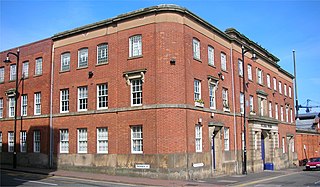
The Victoria Works is a Grade II listed building in the Jewellery Quarter of Birmingham, England. It was built in 1839–40 for Joseph Gillott, who manufactured pen nibs, and was one of the first purpose-built factories in the Jewellery Quarter. It is situated opposite the Argent Centre, another building constructed for industrial use around the same period. The factory was one of the largest of its kind, with nearly 600 workers. Steam engines of 60 horsepower powered the mass production of the nibs.

The Windsor Street Gasworks was a coal gas and coke manufacturing site in Nechells, Birmingham. The works were constructed in 1846 for the Birmingham Gas Light and Coke Company adjacent to the Birmingham and Fazeley Canal to allow for the bulk import of coal. The company was taken over by the Birmingham Corporation in 1875 and under mayor Joseph Chamberlain and engineer Charles Hunt the Windsor Street site was expanded and connected to the London and North Western Railway. Hunt's works included the construction, in 1885, of gasholders No. 13 and No.14, the largest in the world at that time, as well as modernisation of production.



















